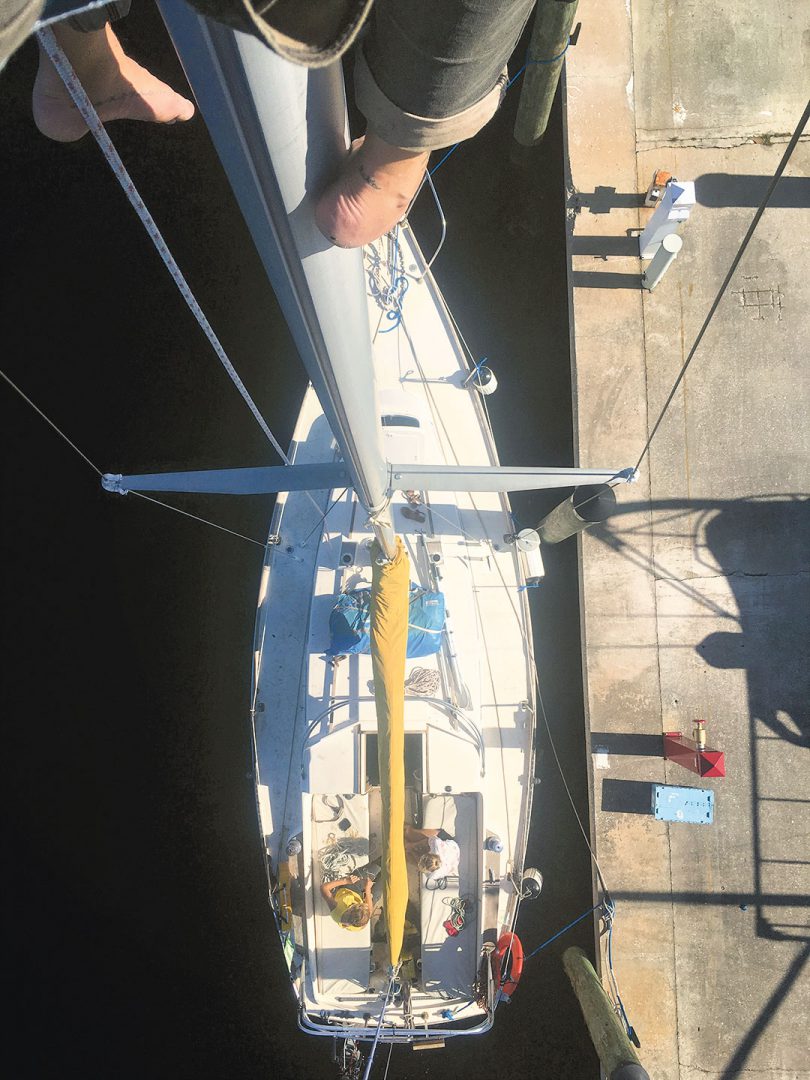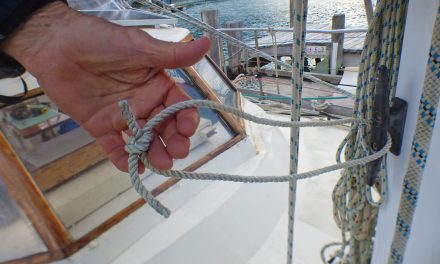No halyard? No bosun’s chair? No problem for this crew.
Issue 135: Nov/Dec 2020

Jinks’ crewmember, Gray, preps to go up the mast.
It was a warm July day when my crew and I set out from Chesapeake Bay aboard Sequoia, our modest but trusty 1977 Tartan 30. Our destination was our home port of New Orleans, and every old salt on every dock en route pointed out that we were headed the wrong way—south, into hurricane season.
We knew it was true, but we were on a mission—with a deadline—so we salved our anxiety by obsessively comparing forecasts until hurricanes loomed in our dreams. By the time we reached Miami’s crowded, drag-prone anchorages, five named storms had stacked up in the waters between us and West Africa. The crew convened over coffee to map options, but there was no way around it: It was time to abort and lock down. Overnight, our focus changed to locating local hurricane holes to preempt the rush of cruisers and liveaboards out of Miami.
And it’s well we did, as Sequoia ended up riding out a direct hit from a Category 4 hurricane in a tangle of Florida mangroves. Due to our thorough preparation and a spot of good fortune, she emerged with nothing but a blanket of leaves on her deck as evidence a storm had ever passed her way. It was good news, but none of us realized that undoing our careful storm prep would pose the biggest challenge.
In our haste to strip everything that could produce drag, we’d dropped the main and jib halyards. In the heat of a statewide evacuation, none of us considered the consequences. Our relief for Sequoia’s survival faded as we stared at our useless bosun’s chair, wondering how we’d get the halyards rethreaded. We made call after call to slammed boatyards and riggers with weeks-long waiting periods.
We motored to the nearest town dock, tied off, and immediately fielded intense interest from multitudes of dock loafers who always found our scrappy, man-free crew irresistible. They brought the usual offerings of beer, but we wanted intel. Unfortunately, nobody had DIY’ed this situation before. Somebody alerted us to a yard that could do the job for under a grand, but after a summer cruising down the coast, all our cash put together would still have been a negative number.
Kicking around the docks the next morning, I happened upon a weathered sailboat I had been aboard the previous winter in Central America, after we were both struck by lightning. I called the number the owner had written on the “not abandoned” note. I knew that if anyone would have a crackpot workaround, it would be him.

These three images show steps in the process of creating the Prusik knot to create a sling. Only webbing can safely be used on a mast because rope will roll, and keeping the webbing flat against the mast surface is crucial to maintaining the needed friction to prevent slippage.
When he called me back, he said he’d heard of people using a Prusik knot and Prusik sling to get aloft, but he’d never done it himself. He did, however, have a rock-climbing harness and webbing in his boat, which he offered to let us use. I returned hopeful to Sequoia with the gear and we put our heads together.
Before the sun set, Sequoia and her crew were back under full sail out of Miami on our way to New Orleans. This is how we did it.
Supplies
- Rock-climbing harness with belay loop, to attach to the Prusik sling via carabiner;
- Two locking carabiners that are rated to bear your weight and won’t break if shock-loaded;
- Two 15- to 18-foot lengths of 1– to 2-inch-wide webbing (rope will not work for this application, as it rolls under load);
- A length of paracord longer than the height of the mast, to be used for lifting and lowering items you forget or can’t carry up with you, like the end of a halyard.
Before we start, a little about the knot that is the star of this story, and an overview of what we did. The Prusik knot—named after Austrian mountaineer Karl Prusik, who developed it in the 1930s—is a hitch that slides when unloaded, but grips and holds under load, sort of like a Chinese finger trap. Used in conjunction with a sling, it’s perfect for inchworming up a mast. In fact, rock climbers and arborists use this knot in this way in rescue systems. When done correctly, it is as safe as a bosun’s chair (contrary to the breathless horror with which this method was witnessed by our dockside audience).
In short, we hitched the webbing around the mast to make two slings that slid easily up and down the mast, so long as they were not under load. When either sling bore my weight, it was rock-solid.
Method

Standing in the foot slings, Jinks’ crewmember, Gray, prepares to work her way over the spreaders.
Step 1: Make loops in the webbing using double barrel knots.
Tie each 15-foot length of webbing into a loop. To make the loops, I tied two barrel knots (aka fisherman knots) at the ends of the webbing that pull against each other. This is called a double barrel knot.
Step 2: Hitch the loops to the mast via Prusik knots, creating Prusik slings.
One at a time, secure both loops around the mast using the Prusik knot, one above the other, separate from each other. Prusik knots are commonly tied rope-to-rope for the same slide/grab effect I was after, but here I didn’t have the rope-to-rope friction, I had webbing on a smooth aluminum surface, so surface area was critical. For each knot to maximize surface area, I was careful to ensure the webbing laid flat against the mast and beneath any existing lines (though we had no lines to worry about!). In fact, so critical is friction to the success of the Prusik knot that if there is anything that compromises the friction of the mast (such as rain or oil), do not use this method.
Step 3. Attach yourself to the slings.

The view from above.
With both loops—now Prusik slings—hitched to the mast, one atop the other, I could have begun my climb. But safety comes first, so I took a minute to clip one of the carabiners to the belay loop on my harness and to the loop of the uppermost, or waist, Prusik sling. Next, I sat back and allowed my weight to rest on the sling, observing how the Prusik knot tightened and settled. Then, I stepped into the bottom, or foot, Prusik sling. When I stood, the waist sling was unloaded, and I found that I could scoot it up the mast. I took care each time to not allow the bands of webbing to cross each other or to bunch—again, focused on that necessary webbing-to-mast friction.
Step 2. Ascend.
Satisfied I knew what to do and that everything was working as expected, I ascended. With my foot loading the lower foot sling, it was easy to scoot the waist sling up. But after putting my weight back on the waist sling and unloading the foot sling, I realized it’s important not to get the two slings too far apart. Too far apart and I found it’s difficult to reach the foot sling to pull it up after me. Baby steps up, not leaps. I found this inching up to be the fun part and I soon got the hang of it.
Step 5. Negotiating the spreader zone.

Jinks leans her right foot firmly into one of the Prusik slings on her way up.
Once I reached the base of the spreaders, I untied the foot sling and retied it above the spreaders. This retied foot sling was now my new waist sling, and it was important that I attached to it with a second carabiner, without unclipping the first. Before loading this sling above the spreaders, I scooted it up to make just enough room below it (and above the spreaders) to hitch the next sling. Then, I pulled myself up, attached to the new waist sling, and leaned back to load it. Next, I unclipped from the former waist sling (still beneath the spreaders), untied it, and retied it above the spreaders and below the new waist sling I was hanging from. I was back in business to continue ascending.
Step 6. Self-care and getting things you need.
By now, my mouth was dry, and I dropped one end of paracord down to my gallant crew, like Rapunzel’s hair, but hoping they’d attach something more useful than a prince. After quenching my thirst, I used the paracord to pull up the ends of the halyards.
Step 7. Descent.
By the time I’d threaded the halyards back through their masthead sheaves, my legs were deadened by lack of circulation and I knew it was time to descend. With gravity working with me, this was easy. I simply stood in the foot sling and slid the unloaded waist sling down to just above the foot sling, loaded the waist sling, and slid the foot sling down—over and over. I was careful to never grab the webbing loops around the mast when my weight was on them because I realized that can cause the webbing to fail to grip and to keep sliding. I found that keeping weight on the loop part of the hitch served to maintain tension and to control my descent.
Once I was back on deck, the crew and I popped open some cold ones and commenced storytelling. I’d just gone up and down my mast safely with nary a halyard; I plan to get a lot of mileage out of that story.
Jinks Holladay has logged all her most memorable sea miles aboard classic plastic sailboats under 30 feet. She is a member of Ladyjacks, a network of lady captains, sailors, and boat owners.
Thank you to Sailrite Enterprises, Inc., for providing free access to back issues of Good Old Boat through intellectual property rights. Sailrite.com





